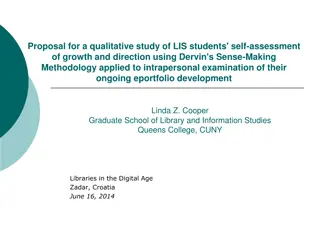Embracing Automation: Challenges and Opportunities for Good Jobs and Wages
Technology and automation raise questions regarding the future of job growth, wage inequality, and the impact on unemployment. Looking at past trends and projections, the discussion explores whether automation will lead to joblessness or spur new opportunities. Emphasizing the potential for higher incomes and job creation, the analysis encourages a proactive approach to leveraging automation for societal benefit.
Download Presentation

Please find below an Image/Link to download the presentation.
The content on the website is provided AS IS for your information and personal use only. It may not be sold, licensed, or shared on other websites without obtaining consent from the author. Download presentation by click this link. If you encounter any issues during the download, it is possible that the publisher has removed the file from their server.
E N D
Presentation Transcript
Do not fear the robots: The challenge is good jobs at good wages Larry Mishel, President Economic Policy Institute @Larrymishel
Lets be clear about technology Consumer products: your phones, TVs, stoves, etc. improve; Communications: Wi-Fi, internet Automation: in workplace the substitution of capital (equipment/software) for labor What s Amazon? What s Uber? Robots?
What are the issues? Technology is a large topic. Robots are a smaller topic: capital replacing human labor and possibly eroding the total number of jobs and the skill composition of jobs. 1. Number of Jobs: Will technology (i.e., Robots!) slow aggregate job growth, raise unemployment? 2. Wage Inequality: Will technology (i.e., Robots!) create only high-skilled, high-wage jobs, leaving non-college-educated workforce behind? www.epi.org 3
Impact of automation/robots? Joblessness Past Recent, 1999-2016 Post WWII Inequality Past Recent, 1999-2016 Post WWII Future Immediate Decades away Future Immediate Decades away
Where can we look for evidence? Recent past, 1999-2007 and 2007-14: 2MA claims trends are already evident. If not, then why do we think the future will reflect their story? Projections: Oh wow stories? Examine various projections. www.epi.org 5
A jobless future? Given not in the past! Automation eliminates jobs in specific occupations and industries but does it lead to overall joblessness? Why have we not seen ever-rising unemployment over last century or more?; Or, how did unemployment drop from 10% to under 5% since 2010 if we re in a job-killing automation surge? www.epi.org 6
Ok, automation happens but then what? Only done to cut costs, right? When costs drop then what? Lower prices Higher incomes, some combo ofhigher profits and higher wages Those who bought automated good or service in future will buy more of that item, or of other items. Higher incomes spent. Unless we have run out of needs and capitalists fail to satisfy them, even invent some; Poof: more jobs created. Will next time be different? www.epi.org 7
Wheres the Footprint of accelerated automation? www.epi.org 8
Other indicators Displacement Job loss
The Second Machine Age (2MA) story of increasing joblessness? www.epi.org 12
www.epi.org 13
www.epi.org 14
If not now, in future? Scale of impact Time frame First order impact only? Measured against past trends www.epi.org 15
Two stories about wage inequality 1. Education need for college graduates driven by technology/computers Occupations job polarization computers erode middle, expand relative demand for non-routine, cognitive skills expands at top and do not affect routine, manual work at bottom 2.
Polarization? Occupational employment polarization can t possibly explain wage trends since 1999 1. Silent on top 1.0%; 2. Polarization not present since 1999; 3. Occupational employment patterns unrelated to relative wage trends.
19 Changes in occupation employment shares Changes in overall wage distribution Changes in occupation wages Technology
www.epi.org 20
Source: Reproduced from Levy and Murnane (2013) www.epi.org 21
Why the Skills Deficit/Education Explanation Fails 1. College (4 yr) wage premium flattened after mid-90s, but wage gap still grew strongly; 2. College wages flat, at best, for many years The top 1%
Marxist Explanation Are you going to believe me, or what you see with your own eyes? Groucho Marx Example: unpaid internships Example: lower wages, less benefits for young college grads, underemployment
BLS Occupational Projections By wage level By education requirements
www.epi.org 34
Gig Economy, Self-Employment are not Future of Work! At a Future of Work conference the gig economy or freelancing deserves workshops, not a plenary
Growth of Alternative Work Arrangements, 1995-2015 Percent of Employment Change 2005-15 5.1 1.5 0.9 0.7 1.7 Type All alternative work arrangements Independent contractors On-call workers Temporary help agency workers Workers provided by contracting firms 1995 10.0 6.3 1.6 1.0 1.3 2005 10.7 6.9 1.7 0.9 1.4 2015 15.8 8.4 2.6 1.6 3.1 Memo: Work through online intermediary 0.0 0.0 0.5 0.5 Source: Katz and Krueger, September 2016
Scaling Uber and Gig wages paid Uber driver pay, 2015 Annual pay: $4.70 Billion Pay net of expenses: $3.76 Billion Uber pay relative to economy: % private wages 0.06%, (i.e. .0006 of total) % private compensation 0.05% Uber is two-thirds of gig economy, so Gig Economy was about 0.1% of private wages in 2015
What really happened: Policy choices, on behalf of those with most wealth and power, that have undercut wage growth of a typical worker: 1. Excessive unemployment; 2. Fissured economy; 3. Weakened labor standards; 4. Globalization; 5. Eroded institutions: collective bargaining 6. Top 1.0% wage/income growth www.epi.org 40
Raising Americas Pay Full Employment Restrain top 1% incomes (Finance, Executive pay) Restore labor standards (min wage, OT, wage theft, misclassification, forced arbitration, undocumented workers) Modernize labor standards (earned sick leave, family leave, fair work week/scheduling) Rebuild collective bargaining See: http://www.epi.org/pay/














